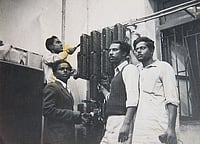Where is the revolution? This issue has baffled me since the time Saddam Hussain invaded Kuwait. It is only after this event that media planners' career graphs went on an upswing. Even as the world was cursing Saddam, media planners were showering petals at his feet for what the invasion had done to them. Thanks to the explosion of satellite channels which started immediately after the war, media planners became a highly sought-after commodity. And now it is imperative to have a media planner in any client meeting. Everybody wants to know which channel would be the right one for his brand. Should he look towards TV at all? And so the media planner came into play in a big way with all his skills by way of judgement, gut-feel and experience.
Exploding The Myth
Is the satellite TV invasion as pervasive as it is made out to be?

Nobody is complaining. But the other day, I sat wondering about two things—first, why is everybody talking about this media revolution so ferociously, and secondly, if the revolution has really happened, then with what intensity?
I think in this case it is due to our belief that whatever is happening to us in big cities, is happening to the whole nation. Sadly, this is not true. For example, the revolution has reportedly happened mainly because of what we call the 'idiot-box'. So it would make sense to fix a number on the idiot boxes available in the country. Today, there are 50 million TV sets in the country with 34 million black and white sets and 16 million colour TV sets. Four and a half million of the 16 million colour TV sets are equipped with remote facility. These 4.5 million households are the ones for whom the revolution has really happened because in a black and white set or a colour set without a remote one can access only 8 to 10 channels. And these programmed channels are seldom changed.
Even though these 4.5 million households may seem like a drop in the ocean, considering the fact that there are 920 million people in the country, the bottomline is that even these premium, affluent households cannot tune in to more than 16 channels. The reason: unless you have a set-top converter you cannot receive the S-band frequency. Your TV may be capable of receiving up to 80 channels but after the 16th channel the first one will be programmed again. All Indian TV sets manufactured before July 1995 have this problem. I wonder why no consumer forum or body has taken these leading TV manufacturers to court as all advertising put out by these companies proudly claimed that their sets could receive up to 80 channels.
This, with consumers, became a motivating point and an important parameter for deciding on a particular brand. Now, there are manufacturers who are making set top converters for Rs 2,500 to enable the TV set to receive more channels. TV manufacturers have also taken the hint and sets being manufactured now have the provision for receiving all frequencies.
My point is yet not over. The other side of the coin is the transmitting cable. Small-time businessmen became cable operators for the quick buck. The result: not many invested in hardware. You will notice that a majority of cables installed are 5 to 6 core whereas to take up to 30 to 40 channels, I am told you need a minimum of 10 to 12 core cable. This has not happened in spite of the entire cable operation in big cities being controlled by three to four big players. This is why on some channels it is always raining!
Now to the most interesting point. Savvy media sellers have been visiting media planners and brand managers with alarming frequency to enlighten them on the reach their channels can offer. These networks claim a high penetration, not realising that their transmission doesn't get into the household. It only reaches the cable operator. This could be because the household has a TV without a remote or it has already tuned 16 channels and can't get more.
Did somebody mention the second TV? Well, according to ORG, 99 per cent of urban India has one-TV households and the sales of 14 inch TVs ( see graph ) are anything but encouraging. It is most unlikely that a 20 or 21 inch TV gets into the house as a second TV. The 25 inch and 29 inch TV sales are a fraction of the 14 inch TV sales.
During one of my market visits to these cable operators, I was pleasantly surprised that in areas like Janakpuri, Karol Bagh and Mayur Vihar, the penetration of south Indian channels like Sun TV and Asianet was high as there is a sizeable south Indian (five lakh households) population in Delhi alone. This, I am sure, will be true for even areas like Matunga and Dombivili in Bombay. This would surely give you an idea about the state of other channels in these areas. Now to the critical question: in such a scenario how do networks market themselves? One option is that networks should stop having ratecards based on viewership and instead have pricing of programmes based on responses of viewers.
?The other option would be to hang around till the Turners and the Murdochs come in and buy them out. The latter seems to be a more feasible option and will probably happen by the end of the year. Or maybe, even earlier.





















